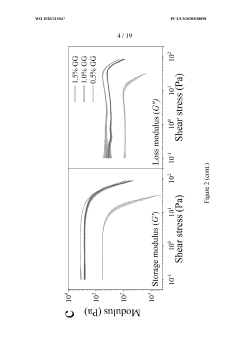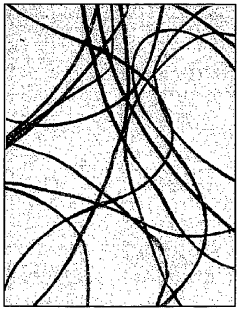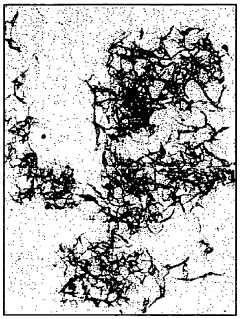Revolutionary PTFE Advances in Manufacturing
JUN 27, 20259 MIN READ
Generate Your Research Report Instantly with AI Agent
Patsnap Eureka helps you evaluate technical feasibility & market potential.
PTFE Evolution and Objectives
Polytetrafluoroethylene (PTFE), commonly known as Teflon, has been a revolutionary material since its accidental discovery by Roy Plunkett in 1938. This synthetic fluoropolymer has undergone significant evolution over the past eight decades, transforming manufacturing processes across various industries.
The development of PTFE can be traced through several key phases, each marked by technological breakthroughs and expanding applications. Initially, PTFE was primarily used in military and aerospace applications due to its unique properties. As manufacturing techniques improved, its use expanded into consumer goods, particularly non-stick cookware in the 1960s.
The 1970s and 1980s saw PTFE's integration into industrial processes, with the material finding applications in chemical processing, electronics, and automotive industries. This period was characterized by advancements in PTFE's formulation and processing techniques, leading to enhanced performance characteristics.
In recent years, the focus has shifted towards developing more environmentally friendly and sustainable PTFE manufacturing processes. This includes efforts to reduce the use of perfluorooctanoic acid (PFOA) and other potentially harmful chemicals in PTFE production, aligning with global sustainability goals.
The current objectives in PTFE manufacturing revolve around several key areas. Firstly, there is a push for the development of PTFE with enhanced properties, such as improved wear resistance, higher temperature tolerance, and better chemical resistance. These advancements aim to expand PTFE's applicability in extreme environments and specialized industries.
Secondly, researchers are exploring novel manufacturing techniques to produce PTFE with more precise control over its microstructure. This includes advancements in sintering processes, the development of nano-engineered PTFE, and the creation of PTFE composites with tailored properties.
Another significant objective is the optimization of PTFE recycling processes. As environmental concerns grow, there is an increasing focus on developing efficient methods to recycle and reuse PTFE products, reducing waste and improving the material's lifecycle sustainability.
Lastly, the industry is working towards more cost-effective production methods. This involves improving manufacturing efficiency, reducing energy consumption, and developing new catalysts and precursors for PTFE synthesis. These efforts aim to make PTFE more accessible for a wider range of applications while maintaining its superior performance characteristics.
The development of PTFE can be traced through several key phases, each marked by technological breakthroughs and expanding applications. Initially, PTFE was primarily used in military and aerospace applications due to its unique properties. As manufacturing techniques improved, its use expanded into consumer goods, particularly non-stick cookware in the 1960s.
The 1970s and 1980s saw PTFE's integration into industrial processes, with the material finding applications in chemical processing, electronics, and automotive industries. This period was characterized by advancements in PTFE's formulation and processing techniques, leading to enhanced performance characteristics.
In recent years, the focus has shifted towards developing more environmentally friendly and sustainable PTFE manufacturing processes. This includes efforts to reduce the use of perfluorooctanoic acid (PFOA) and other potentially harmful chemicals in PTFE production, aligning with global sustainability goals.
The current objectives in PTFE manufacturing revolve around several key areas. Firstly, there is a push for the development of PTFE with enhanced properties, such as improved wear resistance, higher temperature tolerance, and better chemical resistance. These advancements aim to expand PTFE's applicability in extreme environments and specialized industries.
Secondly, researchers are exploring novel manufacturing techniques to produce PTFE with more precise control over its microstructure. This includes advancements in sintering processes, the development of nano-engineered PTFE, and the creation of PTFE composites with tailored properties.
Another significant objective is the optimization of PTFE recycling processes. As environmental concerns grow, there is an increasing focus on developing efficient methods to recycle and reuse PTFE products, reducing waste and improving the material's lifecycle sustainability.
Lastly, the industry is working towards more cost-effective production methods. This involves improving manufacturing efficiency, reducing energy consumption, and developing new catalysts and precursors for PTFE synthesis. These efforts aim to make PTFE more accessible for a wider range of applications while maintaining its superior performance characteristics.
PTFE Market Demand Analysis
The global PTFE market has been experiencing steady growth, driven by increasing demand across various industries. The unique properties of PTFE, including its exceptional chemical resistance, low friction coefficient, and high temperature stability, have made it an indispensable material in numerous applications. The automotive sector has emerged as a significant consumer of PTFE, utilizing it in gaskets, seals, and bearings due to its ability to withstand harsh environments and reduce friction. This trend is expected to continue as the automotive industry shifts towards electric vehicles, where PTFE's properties can contribute to improved efficiency and longevity of components.
In the electronics industry, the demand for PTFE has surged with the proliferation of high-frequency applications in 5G technology and advanced computing systems. PTFE's excellent dielectric properties make it ideal for insulation in cables, connectors, and printed circuit boards, where signal integrity is crucial. As the Internet of Things (IoT) expands and data centers grow, the need for PTFE in electronic applications is projected to increase significantly.
The medical sector represents another key market for PTFE, with applications in implants, surgical instruments, and pharmaceutical processing equipment. The material's biocompatibility and non-stick properties have made it valuable in creating innovative medical devices and improving patient outcomes. As healthcare technology advances and the global population ages, the demand for PTFE in medical applications is expected to rise.
Industrial processes and chemical manufacturing continue to be major consumers of PTFE, particularly in the form of coatings, linings, and seals for equipment exposed to corrosive substances. The material's resistance to a wide range of chemicals and its ability to maintain its properties under extreme conditions make it essential in these sectors. With increasing focus on safety and efficiency in industrial operations, the demand for PTFE-based solutions is likely to grow.
The construction industry has also recognized the benefits of PTFE, particularly in architectural membranes and coatings. Its durability, weather resistance, and self-cleaning properties have led to its use in innovative building designs and long-lasting exterior applications. As sustainable and energy-efficient construction practices gain prominence, PTFE's role in this sector is expected to expand.
Market analysis indicates that the Asia-Pacific region is becoming a major growth driver for PTFE demand, fueled by rapid industrialization, infrastructure development, and increasing manufacturing activities. North America and Europe continue to be significant markets, with a focus on high-performance applications and technological advancements in PTFE manufacturing processes.
In the electronics industry, the demand for PTFE has surged with the proliferation of high-frequency applications in 5G technology and advanced computing systems. PTFE's excellent dielectric properties make it ideal for insulation in cables, connectors, and printed circuit boards, where signal integrity is crucial. As the Internet of Things (IoT) expands and data centers grow, the need for PTFE in electronic applications is projected to increase significantly.
The medical sector represents another key market for PTFE, with applications in implants, surgical instruments, and pharmaceutical processing equipment. The material's biocompatibility and non-stick properties have made it valuable in creating innovative medical devices and improving patient outcomes. As healthcare technology advances and the global population ages, the demand for PTFE in medical applications is expected to rise.
Industrial processes and chemical manufacturing continue to be major consumers of PTFE, particularly in the form of coatings, linings, and seals for equipment exposed to corrosive substances. The material's resistance to a wide range of chemicals and its ability to maintain its properties under extreme conditions make it essential in these sectors. With increasing focus on safety and efficiency in industrial operations, the demand for PTFE-based solutions is likely to grow.
The construction industry has also recognized the benefits of PTFE, particularly in architectural membranes and coatings. Its durability, weather resistance, and self-cleaning properties have led to its use in innovative building designs and long-lasting exterior applications. As sustainable and energy-efficient construction practices gain prominence, PTFE's role in this sector is expected to expand.
Market analysis indicates that the Asia-Pacific region is becoming a major growth driver for PTFE demand, fueled by rapid industrialization, infrastructure development, and increasing manufacturing activities. North America and Europe continue to be significant markets, with a focus on high-performance applications and technological advancements in PTFE manufacturing processes.
PTFE Manufacturing Challenges
Polytetrafluoroethylene (PTFE) manufacturing has long been a challenging process due to the unique properties of this versatile material. The high melting point and exceptional chemical resistance that make PTFE valuable also contribute to significant production difficulties. Traditional manufacturing methods often struggle with achieving consistent quality, maintaining dimensional stability, and minimizing waste.
One of the primary challenges in PTFE manufacturing is the material's high viscosity in its molten state. This characteristic makes it difficult to process using conventional thermoplastic techniques such as injection molding or extrusion. As a result, specialized methods like compression molding and ram extrusion have been developed, but these processes are often slow and labor-intensive, leading to higher production costs and limited scalability.
Another significant hurdle is the tendency of PTFE to shrink and deform during the sintering process. This phase transition can cause dimensional instability in the final product, requiring careful control of heating and cooling rates. Manufacturers must also contend with the material's poor heat conductivity, which can lead to uneven heating and potential defects in larger or more complex parts.
The production of thin PTFE films and coatings presents its own set of challenges. Achieving uniform thickness and adhesion to substrates can be problematic, particularly when dealing with large surface areas or intricate geometries. Additionally, the non-stick properties that make PTFE desirable in many applications also make it difficult to bond with other materials, limiting its use in certain composite structures.
Environmental concerns have also become increasingly relevant in PTFE manufacturing. The traditional production process involves the use of perfluorooctanoic acid (PFOA), a persistent organic pollutant. Regulatory pressure has pushed the industry to develop PFOA-free manufacturing methods, which has required significant research and development efforts to maintain product performance while eliminating harmful substances.
The recycling and reprocessing of PTFE waste remain challenging due to the material's chemical inertness and high melting point. Unlike many other plastics, PTFE cannot be easily melted and reformed, leading to increased waste and environmental impact. Developing efficient recycling technologies for PTFE is crucial for improving the sustainability of its production and use.
As demand for PTFE continues to grow across various industries, addressing these manufacturing challenges has become a priority for researchers and manufacturers alike. Innovations in processing techniques, material formulations, and equipment design are being pursued to overcome these obstacles and unlock new possibilities for PTFE applications.
One of the primary challenges in PTFE manufacturing is the material's high viscosity in its molten state. This characteristic makes it difficult to process using conventional thermoplastic techniques such as injection molding or extrusion. As a result, specialized methods like compression molding and ram extrusion have been developed, but these processes are often slow and labor-intensive, leading to higher production costs and limited scalability.
Another significant hurdle is the tendency of PTFE to shrink and deform during the sintering process. This phase transition can cause dimensional instability in the final product, requiring careful control of heating and cooling rates. Manufacturers must also contend with the material's poor heat conductivity, which can lead to uneven heating and potential defects in larger or more complex parts.
The production of thin PTFE films and coatings presents its own set of challenges. Achieving uniform thickness and adhesion to substrates can be problematic, particularly when dealing with large surface areas or intricate geometries. Additionally, the non-stick properties that make PTFE desirable in many applications also make it difficult to bond with other materials, limiting its use in certain composite structures.
Environmental concerns have also become increasingly relevant in PTFE manufacturing. The traditional production process involves the use of perfluorooctanoic acid (PFOA), a persistent organic pollutant. Regulatory pressure has pushed the industry to develop PFOA-free manufacturing methods, which has required significant research and development efforts to maintain product performance while eliminating harmful substances.
The recycling and reprocessing of PTFE waste remain challenging due to the material's chemical inertness and high melting point. Unlike many other plastics, PTFE cannot be easily melted and reformed, leading to increased waste and environmental impact. Developing efficient recycling technologies for PTFE is crucial for improving the sustainability of its production and use.
As demand for PTFE continues to grow across various industries, addressing these manufacturing challenges has become a priority for researchers and manufacturers alike. Innovations in processing techniques, material formulations, and equipment design are being pursued to overcome these obstacles and unlock new possibilities for PTFE applications.
Current PTFE Manufacturing Solutions
01 PTFE manufacturing processes
Various methods for producing PTFE are described, including polymerization techniques, extrusion processes, and molding methods. These processes aim to improve the quality, efficiency, and properties of the resulting PTFE materials.- PTFE manufacturing and processing methods: Various techniques for manufacturing and processing PTFE are described, including methods for producing PTFE fibers, films, and molded articles. These processes often involve specific temperature and pressure conditions, as well as the use of specialized equipment to achieve desired properties in the final PTFE products.
- PTFE composites and blends: PTFE is often combined with other materials to create composites or blends with enhanced properties. These combinations can improve characteristics such as wear resistance, thermal conductivity, or mechanical strength. The resulting materials find applications in various industries, including automotive, aerospace, and electronics.
- Surface modification of PTFE: Techniques for modifying the surface of PTFE materials are explored to enhance properties such as adhesion, wettability, or biocompatibility. These modifications can involve chemical treatments, plasma processing, or the application of coatings to alter the surface characteristics of PTFE without compromising its bulk properties.
- PTFE in membrane and filtration applications: PTFE's unique properties make it suitable for use in membrane and filtration technologies. These applications leverage PTFE's chemical resistance, low surface energy, and porous structure to create efficient and durable filtration systems for various industries, including water treatment and gas separation.
- Recycling and environmental considerations of PTFE: Methods for recycling PTFE and addressing environmental concerns related to its production and disposal are discussed. These approaches aim to reduce waste, improve sustainability, and develop more eco-friendly processes for PTFE manufacturing and end-of-life management.
02 PTFE composite materials
PTFE is often combined with other materials to create composite structures with enhanced properties. These composites may include reinforcing fibers, nanoparticles, or other polymers to improve strength, wear resistance, or thermal conductivity.Expand Specific Solutions03 Surface modification of PTFE
Techniques for modifying the surface of PTFE are explored to enhance its adhesion properties, wettability, or compatibility with other materials. These modifications can involve chemical treatments, plasma processing, or the application of coatings.Expand Specific Solutions04 PTFE in filtration and separation applications
PTFE membranes and filters are developed for various separation processes, including water treatment, air purification, and chemical filtration. The material's non-stick and chemical-resistant properties make it ideal for these applications.Expand Specific Solutions05 PTFE in medical and biomedical applications
The use of PTFE in medical devices, implants, and biomedical applications is explored. Its biocompatibility, low friction, and inertness make it suitable for various medical products and treatments.Expand Specific Solutions
Key PTFE Industry Players
The revolutionary PTFE advances in manufacturing are shaping a competitive landscape characterized by rapid technological evolution and expanding market opportunities. The industry is in a growth phase, with increasing demand across various sectors driving market expansion. The global PTFE market size is projected to reach significant figures in the coming years, reflecting its growing importance. Technological maturity varies among key players, with companies like DAIKIN INDUSTRIES Ltd., 3M Innovative Properties Co., and DuPont de Nemours, Inc. leading in innovation and product development. These industry giants are investing heavily in R&D to enhance PTFE properties and applications, while emerging players like Zhejiang Jusheng Fluorochemical Co., Ltd. and Shandong Dongyue Polymer Material Co. Ltd. are also making strides in technological advancements, intensifying competition in this dynamic field.
DAIKIN INDUSTRIES Ltd.
Technical Solution: Daikin has developed advanced PTFE manufacturing techniques, including a unique emulsion polymerization process that produces ultra-fine PTFE particles with improved dispersion characteristics[1]. This innovation allows for the creation of PTFE materials with enhanced thermal stability and chemical resistance. The company has also introduced a novel sintering method that results in PTFE products with superior mechanical properties and reduced porosity[3]. Additionally, Daikin has pioneered the development of modified PTFE grades, incorporating specific monomers during polymerization to tailor the material's properties for specialized applications[5].
Strengths: Superior quality PTFE with customizable properties, advanced manufacturing processes. Weaknesses: Potentially higher production costs, limited to high-end applications.
3M Innovative Properties Co.
Technical Solution: 3M has revolutionized PTFE manufacturing through its proprietary Dyneon TFM modified PTFE technology. This process involves the copolymerization of PTFE with perfluoropropyl vinyl ether (PPVE), resulting in a material with improved creep resistance and lower cold flow compared to standard PTFE[2]. The company has also developed a unique expansion process for creating expanded PTFE (ePTFE) membranes with controlled pore size and distribution, enhancing filtration and breathability characteristics[4]. Furthermore, 3M has introduced nano-structured PTFE composites, incorporating nanoparticles to enhance specific properties such as wear resistance and thermal conductivity[6].
Strengths: Diverse range of modified PTFE products, strong focus on ePTFE applications. Weaknesses: Higher cost compared to standard PTFE, may require specialized processing equipment.
PTFE Innovation Breakthroughs
Fluoropolymer shear-thinning INKS and methods of making and using same
PatentWO2020215047A1
Innovation
- Development of shear-thinning inks comprising PTFE particles, a medium, and a shear-thinning agent like gellan gum, combined with a multistage thermal treatment process for direct ink writing, allowing for the creation of complex PTFE structures with tunable mechanical properties.
Methods for continuous processing polytetrafluoroethylene (PTFE) resin
PatentWO2008094698A1
Innovation
- A method involving the use of colloidal PTFE particles, processed in a slurry form with a wetting liquid, subjected to shearing and sintering to produce isotropic micro-fibers that can be used to create biaxially oriented, reinforced sheets with improved dimensional stability and cohesion, allowing for continuous processing and the incorporation of fillers and reinforcements.
Environmental Impact of PTFE Production
The environmental impact of PTFE production has been a growing concern in recent years, as the manufacturing process involves the use of potentially harmful chemicals and energy-intensive processes. One of the primary environmental issues associated with PTFE production is the emission of perfluorooctanoic acid (PFOA), a persistent organic pollutant that has been linked to various health and environmental risks. Traditional PTFE manufacturing methods have relied heavily on PFOA as a processing aid, leading to its release into the environment through air emissions and wastewater discharge.
However, recent advances in PTFE manufacturing have focused on developing more environmentally friendly production methods. Many manufacturers have committed to phasing out PFOA and other long-chain perfluorinated compounds, replacing them with alternative processing aids that have a lower environmental impact. These new processes aim to reduce or eliminate the use of harmful substances while maintaining the high-performance characteristics of PTFE.
One significant development in this area is the adoption of fluoropolymer emulsion polymerization techniques that use short-chain fluorinated surfactants. These alternatives have shown promising results in terms of reducing environmental persistence and bioaccumulation potential. Additionally, some manufacturers have implemented closed-loop systems and advanced filtration technologies to minimize the release of fluorinated compounds into the environment during production.
Energy consumption is another critical aspect of PTFE production's environmental impact. The high temperatures required for polymerization and sintering processes contribute significantly to the carbon footprint of PTFE manufacturing. To address this issue, researchers and manufacturers are exploring more energy-efficient production methods, such as optimizing reactor designs and implementing heat recovery systems.
Water usage and wastewater management are also important considerations in PTFE production. Traditional manufacturing processes often require large volumes of water for cooling and cleaning purposes. Innovative water recycling and treatment technologies are being developed and implemented to reduce water consumption and minimize the discharge of contaminated wastewater.
As the industry continues to evolve, there is a growing emphasis on life cycle assessment (LCA) approaches to evaluate the overall environmental impact of PTFE products. This holistic view considers not only the production phase but also the use and end-of-life stages of PTFE materials. Such assessments are driving the development of more sustainable PTFE formulations and manufacturing processes, as well as improved recycling and disposal methods for PTFE products.
In conclusion, while PTFE production has historically posed significant environmental challenges, recent advancements in manufacturing techniques are paving the way for more sustainable practices. The industry's focus on reducing harmful emissions, improving energy efficiency, and minimizing water usage demonstrates a commitment to addressing environmental concerns associated with PTFE production.
However, recent advances in PTFE manufacturing have focused on developing more environmentally friendly production methods. Many manufacturers have committed to phasing out PFOA and other long-chain perfluorinated compounds, replacing them with alternative processing aids that have a lower environmental impact. These new processes aim to reduce or eliminate the use of harmful substances while maintaining the high-performance characteristics of PTFE.
One significant development in this area is the adoption of fluoropolymer emulsion polymerization techniques that use short-chain fluorinated surfactants. These alternatives have shown promising results in terms of reducing environmental persistence and bioaccumulation potential. Additionally, some manufacturers have implemented closed-loop systems and advanced filtration technologies to minimize the release of fluorinated compounds into the environment during production.
Energy consumption is another critical aspect of PTFE production's environmental impact. The high temperatures required for polymerization and sintering processes contribute significantly to the carbon footprint of PTFE manufacturing. To address this issue, researchers and manufacturers are exploring more energy-efficient production methods, such as optimizing reactor designs and implementing heat recovery systems.
Water usage and wastewater management are also important considerations in PTFE production. Traditional manufacturing processes often require large volumes of water for cooling and cleaning purposes. Innovative water recycling and treatment technologies are being developed and implemented to reduce water consumption and minimize the discharge of contaminated wastewater.
As the industry continues to evolve, there is a growing emphasis on life cycle assessment (LCA) approaches to evaluate the overall environmental impact of PTFE products. This holistic view considers not only the production phase but also the use and end-of-life stages of PTFE materials. Such assessments are driving the development of more sustainable PTFE formulations and manufacturing processes, as well as improved recycling and disposal methods for PTFE products.
In conclusion, while PTFE production has historically posed significant environmental challenges, recent advancements in manufacturing techniques are paving the way for more sustainable practices. The industry's focus on reducing harmful emissions, improving energy efficiency, and minimizing water usage demonstrates a commitment to addressing environmental concerns associated with PTFE production.
PTFE Regulatory Compliance
Regulatory compliance is a critical aspect of PTFE manufacturing and usage, particularly given its widespread applications in various industries. The regulatory landscape for PTFE is complex and multifaceted, encompassing environmental, health, and safety considerations. Key regulatory bodies overseeing PTFE include the Environmental Protection Agency (EPA), the Food and Drug Administration (FDA), and the European Chemicals Agency (ECHA).
One of the primary regulatory concerns surrounding PTFE is the use of perfluorooctanoic acid (PFOA) in its production. PFOA has been linked to various health and environmental issues, leading to stringent regulations on its use. The EPA's PFOA Stewardship Program, initiated in 2006, has resulted in significant reductions in PFOA emissions and product content. Manufacturers have been required to phase out PFOA and related long-chain perfluorinated substances, driving innovation in PTFE production methods.
The FDA regulates PTFE use in food contact applications, ensuring its safety for consumers. PTFE coatings and components must comply with FDA regulations 21 CFR 175.300 and 21 CFR 177.1550, which outline specific requirements for food-grade PTFE materials. These regulations cover aspects such as composition, manufacturing processes, and permissible use conditions.
In the European Union, PTFE falls under the purview of the REACH (Registration, Evaluation, Authorization, and Restriction of Chemicals) regulation. REACH requires manufacturers and importers to register PTFE and provide detailed information on its properties, uses, and potential risks. The regulation also mandates the gradual replacement of hazardous substances with safer alternatives, influencing PTFE manufacturing processes and formulations.
Revolutionary advances in PTFE manufacturing must navigate these regulatory frameworks while striving for innovation. Emerging technologies focus on developing PFOA-free production methods, such as emulsion polymerization using alternative surfactants or telomer-based polymerization techniques. These advancements aim to maintain PTFE's desirable properties while meeting increasingly stringent regulatory requirements.
Compliance with global standards, such as ISO 13485 for medical devices and AS9100 for aerospace applications, is crucial for PTFE manufacturers targeting specific industries. These standards ensure consistent quality and safety across international markets, driving the need for robust quality management systems and documentation practices in PTFE production facilities.
As regulatory scrutiny intensifies, particularly regarding per- and polyfluoroalkyl substances (PFAS), of which PTFE is a member, manufacturers must remain vigilant and adaptable. Ongoing research into the long-term environmental and health impacts of PTFE and related substances may lead to further regulatory changes, necessitating continuous innovation in manufacturing processes and product formulations to ensure compliance and sustainability.
One of the primary regulatory concerns surrounding PTFE is the use of perfluorooctanoic acid (PFOA) in its production. PFOA has been linked to various health and environmental issues, leading to stringent regulations on its use. The EPA's PFOA Stewardship Program, initiated in 2006, has resulted in significant reductions in PFOA emissions and product content. Manufacturers have been required to phase out PFOA and related long-chain perfluorinated substances, driving innovation in PTFE production methods.
The FDA regulates PTFE use in food contact applications, ensuring its safety for consumers. PTFE coatings and components must comply with FDA regulations 21 CFR 175.300 and 21 CFR 177.1550, which outline specific requirements for food-grade PTFE materials. These regulations cover aspects such as composition, manufacturing processes, and permissible use conditions.
In the European Union, PTFE falls under the purview of the REACH (Registration, Evaluation, Authorization, and Restriction of Chemicals) regulation. REACH requires manufacturers and importers to register PTFE and provide detailed information on its properties, uses, and potential risks. The regulation also mandates the gradual replacement of hazardous substances with safer alternatives, influencing PTFE manufacturing processes and formulations.
Revolutionary advances in PTFE manufacturing must navigate these regulatory frameworks while striving for innovation. Emerging technologies focus on developing PFOA-free production methods, such as emulsion polymerization using alternative surfactants or telomer-based polymerization techniques. These advancements aim to maintain PTFE's desirable properties while meeting increasingly stringent regulatory requirements.
Compliance with global standards, such as ISO 13485 for medical devices and AS9100 for aerospace applications, is crucial for PTFE manufacturers targeting specific industries. These standards ensure consistent quality and safety across international markets, driving the need for robust quality management systems and documentation practices in PTFE production facilities.
As regulatory scrutiny intensifies, particularly regarding per- and polyfluoroalkyl substances (PFAS), of which PTFE is a member, manufacturers must remain vigilant and adaptable. Ongoing research into the long-term environmental and health impacts of PTFE and related substances may lead to further regulatory changes, necessitating continuous innovation in manufacturing processes and product formulations to ensure compliance and sustainability.
Unlock deeper insights with Patsnap Eureka Quick Research — get a full tech report to explore trends and direct your research. Try now!
Generate Your Research Report Instantly with AI Agent
Supercharge your innovation with Patsnap Eureka AI Agent Platform!







